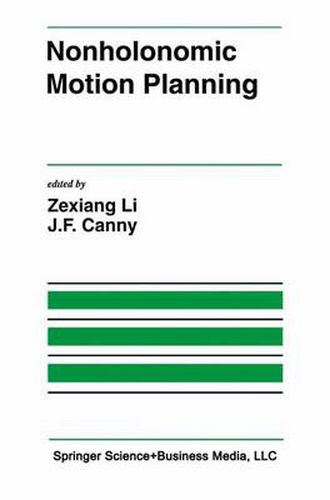Readings Newsletter
Become a Readings Member to make your shopping experience even easier.
Sign in or sign up for free!
You’re not far away from qualifying for FREE standard shipping within Australia
You’ve qualified for FREE standard shipping within Australia
The cart is loading…






This title is printed to order. This book may have been self-published. If so, we cannot guarantee the quality of the content. In the main most books will have gone through the editing process however some may not. We therefore suggest that you be aware of this before ordering this book. If in doubt check either the author or publisher’s details as we are unable to accept any returns unless they are faulty. Please contact us if you have any questions.
Nonholonomic Motion Planning grew out of the workshop that took place at the 1991 IEEE International Conference on Robotics and Automation. It consists of contributed chapters representing new developments in this area. Contributors to the book include robotics engineers, nonlinear control experts, differential geometers and applied mathematicians.
Nonholonomic Motion Planning is arranged into three chapter groups: Controllability: one of the key mathematical tools needed to study nonholonomic motion. Motion Planning for Mobile Robots: in this section the papers are focused on problems with nonholonomic velocity constraints as well as constraints on the generalized coordinates. Falling Cats, Space Robots and Gauge Theory: there are numerous connections to be made between symplectic geometry techniques for the study of holonomies in mechanics, gauge theory and control. In this section these connections are discussed using the backdrop of examples drawn from space robots and falling cats reorienting themselves.
Nonholonomic Motion Planning can be used either as a reference for researchers working in the areas of robotics, nonlinear control and differential geometry, or as a textbook for a graduate level robotics or nonlinear control course.
$9.00 standard shipping within Australia
FREE standard shipping within Australia for orders over $100.00
Express & International shipping calculated at checkout
This title is printed to order. This book may have been self-published. If so, we cannot guarantee the quality of the content. In the main most books will have gone through the editing process however some may not. We therefore suggest that you be aware of this before ordering this book. If in doubt check either the author or publisher’s details as we are unable to accept any returns unless they are faulty. Please contact us if you have any questions.
Nonholonomic Motion Planning grew out of the workshop that took place at the 1991 IEEE International Conference on Robotics and Automation. It consists of contributed chapters representing new developments in this area. Contributors to the book include robotics engineers, nonlinear control experts, differential geometers and applied mathematicians.
Nonholonomic Motion Planning is arranged into three chapter groups: Controllability: one of the key mathematical tools needed to study nonholonomic motion. Motion Planning for Mobile Robots: in this section the papers are focused on problems with nonholonomic velocity constraints as well as constraints on the generalized coordinates. Falling Cats, Space Robots and Gauge Theory: there are numerous connections to be made between symplectic geometry techniques for the study of holonomies in mechanics, gauge theory and control. In this section these connections are discussed using the backdrop of examples drawn from space robots and falling cats reorienting themselves.
Nonholonomic Motion Planning can be used either as a reference for researchers working in the areas of robotics, nonlinear control and differential geometry, or as a textbook for a graduate level robotics or nonlinear control course.